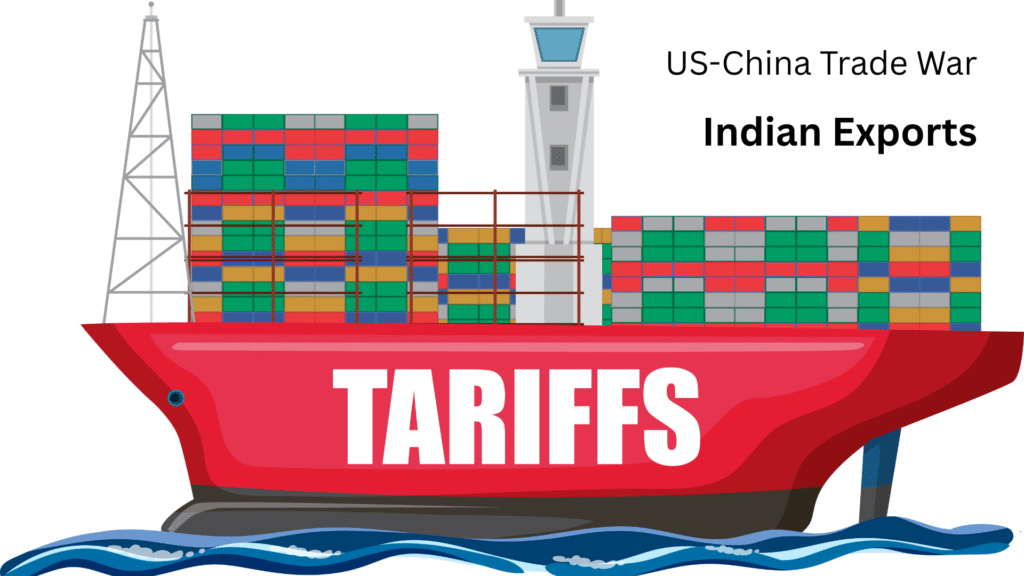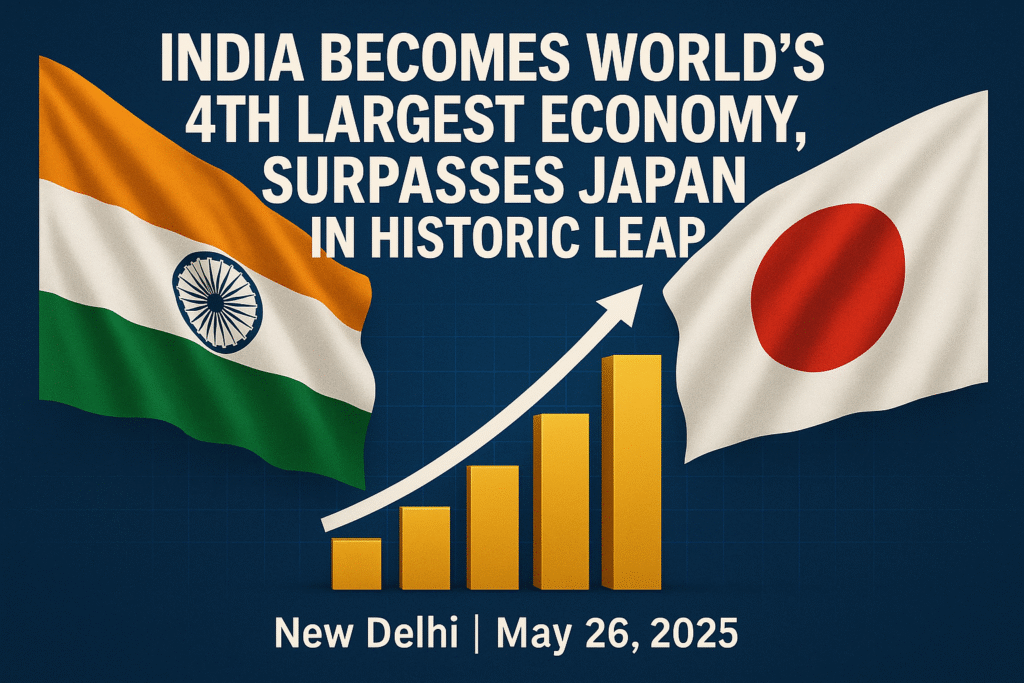US-China Tariff War: India’s Thriving $582 Billion Export Opportunity

The recent escalation of the U.S.-China tariff war in 2025 presents a compelling opportunity for small Indian exporters. With the U.S. imposing significantly higher tariffs on Chinese goods (up to 245% cumulatively on some products), American importers are actively seeking alternative sourcing destinations, and India is well-positioned to fill some of these gaps.
Here’s a sector-wise analysis of the potential, incorporating data and figures:
In order to take share of China’s total $582 billion export to U.S, before US-China tariff war in the year 2024, following industries can contribute significantly:
Apparel and Clothing Accessories:
US-China Tariff War offers great opportunity in this sector for Indian exporters.
- Current Scenario: China is a dominant player in the U.S. apparel import market. NITI Aayog analysis indicates China’s share is around 25%, while India’s is only 3.8%.
- Opportunity: The high tariff differential creates a significant cost advantage for Indian exporters.
- Potential: If India can capture even a small percentage of China’s lost share, the export growth in this sector could be substantial. For example, a 5% shift in U.S. apparel imports from China to India could translate to billions of dollars in new export revenue.
- Data: In 2024, “Articles of apparel or clothing, not knitted” and “Articles of apparel, knit or crocheted” were among India’s top exports to the U.S., valued at $2.53 billion and $2.14 billion, respectively. A significant tariff on Chinese apparel makes Indian exports considerably more competitive.
Chemicals:
- Current Scenario: China is a major global supplier of various chemicals. Increased tariffs make these imports into the U.S. more expensive.
- Opportunity: Indian chemical manufacturers can offer a cost-effective alternative.
- Potential: Organic chemicals were India’s 6th largest export to the U.S. in 2024, valued at $3.86 billion. Increased competitiveness due to tariffs on Chinese chemicals can boost this further.
Plastics and Rubber:
- Current Scenario: Similar to chemicals, China is a significant exporter of plastics and rubber products to the U.S.
- Opportunity: Indian manufacturers can capitalize on the increased cost of Chinese plastics and rubber goods.
- Data: In 2024, “Plastics” and “Rubbers” exports from India to the U.S. were valued at $1.36 billion and $1.06 billion, respectively. Higher tariffs on Chinese equivalents can enhance India’s market share.
Engineering Goods (including Auto Components & Electrical Machinery):
- Current Scenario: China is a large supplier of a wide range of engineering goods to the U.S.
- Opportunity: U.S. companies are looking to diversify their sourcing of these critical components and machinery.
- Potential: “Electrical machinery and equipment” and “Nuclear reactors and machinery” were significant exports from India to the U.S. in 2024, valued at $12.07 billion and $6.67 billion, respectively. Auto components also hold substantial potential. However, recent U.S. tariffs on iron, steel, and auto components might pose a challenge, potentially leading to a $4-5 billion annual drop in engineering shipments to the U.S.
- Data: “Articles of iron or steel” were valued at $2.88 billion in 2024.
Electronics:
- Current Scenario: China dominates the U.S. electronics import market. However, some items like smartphones, tablets, and laptops have received tariff exemptions.
- Opportunity: Opportunities exist for components, sub-assemblies, and other electronic goods not exempted from tariffs. India’s growing electronics manufacturing sector, boosted by government incentives, can leverage this.
- Data: “Telecom Instruments” were a top export to the U.S. in January 2025 at $1.66 billion, showing significant growth. Overall electronic exports registered a 32% jump in FY25.
Pharmaceuticals:
- Current Scenario: India is already a major supplier of pharmaceuticals, especially generics, to the U.S.
- Opportunity: Concerns about supply chain resilience and the increased cost of some Chinese APIs (Active Pharmaceutical Ingredients) can further strengthen India’s position.
- Data: “Pharmaceutical products” were a leading export in 2024 at $10.97 billion, and “Drug Formulations, Biologicals” also showed strong export figures.
Textiles and Leather:
- Current Scenario: These are traditional strengths of India, but China has a larger share in the U.S. market.
- Opportunity: Increased tariffs on Chinese textiles and leather goods can make Indian products more price-competitive.
- Data: “Other made-up textile articles” and “Articles of apparel or clothing, not knitted” were significant exports in 2024. “Articles of leather” were valued at $757.97 million.
Toys:
- Current Scenario: The U.S. is a large toy market with significant imports from China.
- Opportunity: Higher tariffs on Chinese toys are leading U.S. buyers to seek alternatives in countries like India.
- Data: While the specific value of toy exports to the U.S. might be smaller compared to other sectors (around $280 million in 2024), the growth potential due to tariffs is notable.

- The U.S. is India’s largest export market. In 2024, India’s goods exports to the U.S. totaled $87.4 billion, a 4.5% increase from 2023 ($83.7 billion).
- India’s total goods and services exports in 2024-25 reached a record $820.93 billion, up 5.50% from the previous financial year.
- The U.S. has imposed cumulative tariffs of up to 245% on some Chinese imports. China has retaliated with tariffs up to 125% on U.S. goods.
- The U.S. is actively looking to diversify its supply chains away from China, viewing India as a crucial partner.
Challenges and Mitigation due to US-China Tariff War:
- Potential Import Surge from China: As China faces higher tariffs in the U.S., there’s a risk of them diverting goods to other markets, including India, potentially undercutting domestic manufacturers. The Indian government has established an import surge monitoring group to address this.
- Reliance on Chinese Components: Some Indian industries, like electronics and pharmaceuticals, rely on Chinese components. Increased costs or disruptions in these supplies due to the trade war could negatively impact Indian exporters.
- Competition from Other Nations: Countries like Vietnam and Mexico are also benefiting from the U.S.-China trade tensions. Indian exporters need to focus on quality, competitive pricing, and building strong relationships to maintain an edge.
Strategies for Small Indian Exporters due to US-China Tariff War:
:

- Focus on Value Addition: Move beyond basic manufacturing to offer higher value-added products that can command better prices and are less susceptible to price competition.
- Embrace Technology: Utilize e-commerce platforms and digital marketing to reach U.S. buyers directly.
- Ensure Quality and Compliance: Meet stringent U.S. quality standards and regulatory requirements.
- Leverage Government Support: Utilize export promotion schemes and engage with Export Promotion Councils.
In conclusion, the U.S.-China tariff war presents a significant window of opportunity for small Indian exporters across various sectors. By strategically targeting the right industries, enhancing competitiveness, and leveraging available support, Indian businesses can expand their footprint in the U.S. market. However, they must also be mindful of potential challenges like trade diversion and supply chain disruptions.
US-China Tariff War & Indian Export Opportunity – Sources and related content:
As tariff wars rage, India tries to steal China’s thunder – The Economic Times
Indian exporters likely to gain from US-China trade war: Sources – The Economic Times
US tariffs on China could make Indian exports more competitive – Exim India
Reciprocal Tariff: How Indian Exporters Can Still Win – ShipGlobal.in
Market Access Initiative (MAI) Scheme – Mcommerce – Ministry of Commerce and Industry

Pingback: India Approves 6th Semiconductor Chip Manufacturing Plant